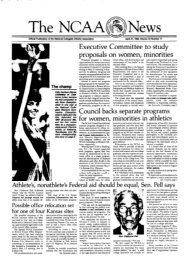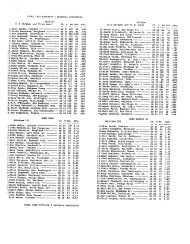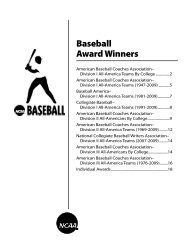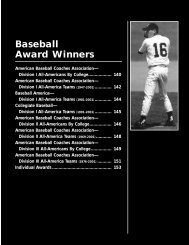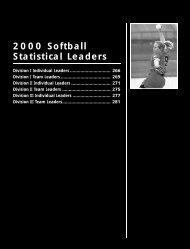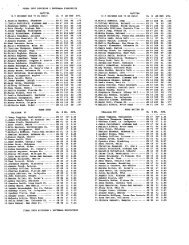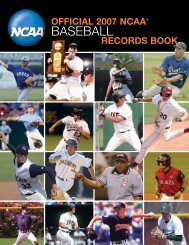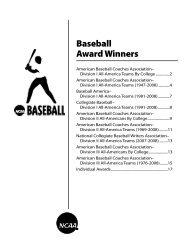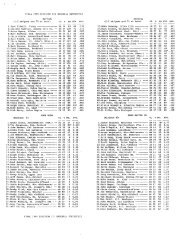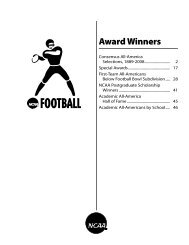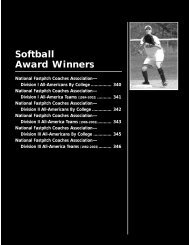The NCAA News
The NCAA News
The NCAA News
Create successful ePaper yourself
Turn your PDF publications into a flip-book with our unique Google optimized e-Paper software.
Smith cites need for perspective<br />
“If you make every game a life-and-death propo-<br />
sition, you’re going to have problems. For one<br />
thing, you’ll be dead a lot.”<br />
Dean Smith said that several years ago as a joke.<br />
But he also still believes it. “I want my players to<br />
have other things they’re intcrcsted in during their<br />
college expenence,” he said. “1 want them to be a<br />
part of the student body. I think our players have<br />
done a pretty good job of it here.”<br />
A “pretty good job” may be an underestimation.<br />
Through Smith’s 30 years as the head men’s basket-<br />
ball coach at the llniversity of North Carolina,<br />
Chapel Hill, approximately 96 percent of his<br />
players have graduated.<br />
While it is safe to say that Smith doesn’t live and<br />
die with basketball, he has been able to mix<br />
the game into the recipe. He has led North Carolina<br />
to the <strong>NCAA</strong> tournament 21 times, including each<br />
of the last I7 years. <strong>The</strong> Tar Heels have been among<br />
the final 16 teams for I I consecutive years. All of<br />
those marks are <strong>NCAA</strong> records. His 47 tournament<br />
wins ties him with John Wooden as the most<br />
successful coach in tournament history.<br />
And, if he continues to pile up the victories at his<br />
career rate of 23.9 per season, some time in the<br />
1996-97 season, Smith will become the all-time<br />
leader in victories, passing Adolph Rupp at 875.<br />
While he said he has no plans to retire “I take<br />
a year at a time; I have said that for about I5<br />
years” achieving coaching records is not one of<br />
his goals.<br />
“That certainly never has been a goal, nor is 11<br />
today,” he says. “1 think too much is said about<br />
coaches’ records. I want to be a teacher. Each year,<br />
Basketball<br />
Continu4vifiom page 22<br />
cept.”<br />
While team play may have been<br />
hurt by the individual exploits of<br />
players, the sport’s popularity con-<br />
tinues to rise. <strong>The</strong> <strong>NCAA</strong> regularly<br />
receives far more ticket applications<br />
than it has seats available for the<br />
Final Four. For example, for the<br />
1991 Final Four in Indianapolis,<br />
Indiana, 143,000 applications (usu-<br />
ally for two tickets apiece) were<br />
received for the 24,000 tickets avail-<br />
able to the general public.<br />
So the game has changed dram<br />
matically. <strong>The</strong> game of the high-<br />
flying, rim-rattling, fast-breaking,<br />
ball-palming behemoths bears little<br />
resemblance to that of their CC)UII-<br />
terparts a century ago, right’?<br />
Not if you listen to the same<br />
coaches who discussed the differ-<br />
ences.<br />
Three basics<br />
“I think there arc three basic<br />
Jack Gardner<br />
things that were true when I played<br />
and all through my days of active<br />
coaching (and that) remain the<br />
same, and will continue to remain<br />
the same,” Wooden said. “Those<br />
three things are getting in the best<br />
possible condition, properly and<br />
quickly executing, and (learning)<br />
the importance of team play.”<br />
Even more basic in his assessment<br />
of the similarities of the game was<br />
former California State University,<br />
Chico, coach Art Acker. Acker was<br />
taught the game of basketball at the<br />
age of 8 by James Naismith, the<br />
inventor of the game, fewer than IO<br />
years after Naismith nailed the first<br />
peach basket to the wall. Shortly<br />
before his death in December 1990,<br />
Ackcr summed up his 91 years of<br />
basketball this way:<br />
“It’s a game of pass, pass, pass.<br />
Basketball was invented as a passing<br />
game. It hasn’t changed one particle<br />
since the day it was invented. Good<br />
I try to have the team do the best it is capable of<br />
doing.”<br />
Those opponents waiting for Smith to get out of<br />
the game may have to be patient. He still ef?lOys<br />
basketball. In fact, he said the worst part of hIsJob<br />
is dealing with tasks unrelated to basketball.<br />
He said the growth of the game is both great and<br />
not in the best interests of the student-athletes.<br />
“We have become the national game because of<br />
television,” he said. “<strong>The</strong> biggest change in my 3 l<br />
years of coaching has been the interest in the Final<br />
Four. We went four out of six years 1967, ‘68, ‘69<br />
and 72. <strong>The</strong>n we didn’t go back until 1977, and I<br />
couldn’t believe the change. It has to be from<br />
television. It was a media event. In 1972, we played<br />
Florida State. I don’t even think it was televised in<br />
every market. And then in 1977, it looked like a<br />
Super Bowl weekend.<br />
“Television makes basketball almost too big. We<br />
arc still colleges and universities. But we (basketball<br />
programs) have become the public relations arm of<br />
the university without meaning to.”<br />
Despite the new lines on his job description,<br />
Smith said he would not choose a different career if<br />
he had the opportunity. His father was the person<br />
who encouraged him to go into coaching. His<br />
college coach, the legendary Forrest “Phog” Allen<br />
of the University of Kansas, who was a doctor of<br />
osteopathy besides being a coach, told Smith to go<br />
mto medicine. “He said coaching had too many<br />
heartaches, too many ups and downs,” Smith said.<br />
For Smith, it has been mostly ups. For the fans of<br />
North Carolina, too. Dean Smith<br />
shooters are nothing but good<br />
passers to the backboard or the<br />
basket. You’ll notice, the good shoot-<br />
ers are good passers, too.”<br />
What about the defenses? Nortlh<br />
Carolina coach Dean Smith said<br />
those who think unrelenting<br />
full-court pressure is a recent<br />
phenomenon are wrong. “<strong>The</strong> pres-<br />
sure man-to-man defense wa:s<br />
started by Dick Harp and Forrest<br />
“Phog” Allen (at Kansas, where<br />
Smith was a player in the early<br />
1950s): Smith said. “You play be-<br />
tween the ball and your man instead<br />
of playing between your man and<br />
the basket. That man-to-man pres-<br />
sure really began late in the 1952<br />
season and then all of 1953. It is still<br />
being done at the college level.<br />
“l‘hc four participants in the Final<br />
Four last year ~ Kansas, North Car-<br />
olina, Duke and Nevada-Las Ve-<br />
gas ~ all used pressure man-to-man<br />
defense. Even though there have<br />
been changes, the idea still is taking<br />
away the passing lanes.”<br />
Easy but difficult<br />
Naismith once was asked by<br />
Allen, one of his most famous pupils<br />
at Kansas, why basketball was SO<br />
popular. Naismith responded, “<strong>The</strong><br />
appeal of basketball is that it is a<br />
game easy to play but difficult to<br />
master.” Allen asked, “You mean<br />
just like life?” Naismith responded,<br />
“Yes, just like life, Forrest.”<br />
So what does the future hold for<br />
this reflection of life? That is where<br />
the veteran coaches differ.<br />
Meyer doesn’t believe the game<br />
can get much bigger. “Television<br />
drew so many fans all over the<br />
country,” he said. “But now, every<br />
night of the week there are three or<br />
four games on TV. People will get<br />
tired of watching it all the time. You<br />
have ESPN, WTBS, WOR,<br />
WGN they are almost all national<br />
hookups. It’s amazing how you can<br />
Gardner keeps the string alive<br />
Every college basketball fan’s dream is to attend<br />
the Final Four.<br />
And while .Iack Gardner is more than a fan, he<br />
has fulfilled his dream 53 straight times. He will<br />
make it 54 later this month when he returns to<br />
Minneapolis, Minnesota, for the first time since he<br />
coached in the 195 I championship game.<br />
Gardner believes hc is the only coach-- and<br />
perhaps the only person- to have attended all 53<br />
championships. It is an cnviablc streak, although<br />
he didn’t intend to start any kind of string when he<br />
attcndcd his first in 1939. He just wanted to get his<br />
till of basketball.<br />
“I was just a basketball nut, and that’s why I did<br />
it,” Gardner said. “I didn’t want to miss anything,<br />
cspccially since I had just taken a job at Kansas<br />
State University. I wanted to pick up and follow the<br />
game the best I could.”<br />
Gardner got help in extending the string when he<br />
attended four Final Fours as a coach. Hc is the only<br />
coach to take two different schools to the Final<br />
Four twice. Each time he went home without a<br />
trophy, and Gardner says his biggest disappointment<br />
in coaching was not winning the national title.<br />
In 1948, his Kansas State team lost to Baylor<br />
University in the semifinals. Three years later, the<br />
Wildcats reached the championship game and led<br />
THE <strong>NCAA</strong> NEWS/March II, 1992 23<br />
go down the street, and people will<br />
recognize you in the various towns.<br />
You have never been there, but<br />
through television, they know you.<br />
“It is exposure. I don’t know how<br />
much bigger the game can get.”<br />
Gardner says the National Bas-<br />
ketball Association will expand to<br />
other countries in the near future.<br />
With expansion, Wooden believes<br />
everybody soon will be playing by<br />
the same rules. Hc sees the use of<br />
the trapezoid-shaped lane. rather<br />
than the rectangular-shaped lane<br />
used in the United States; a 30-<br />
second shot clock, and possibly<br />
even a change to 12-foot baskets.<br />
“<strong>The</strong>re is no progress without<br />
change,” Wooden said. “But you<br />
don’t make a change just for the<br />
sake of change. All change isn’t<br />
progress, but there is absolutely no<br />
progress, whether it be in sports or<br />
business or anything else, without<br />
change.”<br />
the University of Kentucky, 29-27, at half time,<br />
before 7-foot Bill Spivey took over the inside game<br />
and gave Adolph Rupp his third championship in<br />
four years. Gardner left Kansas State in I953 and<br />
moved to the University of LJtah. <strong>The</strong> Utcs reached<br />
the Final Four in 1961 and 1966, losing in the<br />
semifinals both times.<br />
But Gardner’s memories 01 the Final Four arc<br />
not filled with “what-11s.” Fifty-three championship<br />
games, 106 scmiflnal games and 36 third-place<br />
games run through the still-sharp mind of the 80year-old<br />
Gardner. Like any fan, he has his favorites.<br />
“I think my favorite Final Four, and certainly it<br />
was one of the most exciting, was the one that<br />
Michael .lordan won (Jordan hit ajump shot with<br />
IX seconds remaining to lift the Liniversity of North<br />
Carolina, C‘hapcl Hill, to a 63-62 victory over<br />
Georgetown llnivcrsity in 1982):’ Gardner said.<br />
“<strong>The</strong> reason I name that game is because of the<br />
closcncss. I love basketball, and it is just a thrill for<br />
me to see a game go down to a final shot in the<br />
national championship.<br />
“As tar as favorite players (in the Final Four), I<br />
would have to name Bill Walton. He was 21 of 22<br />
(in 1977 against Memphis State in the final). ‘fhat<br />
was a game where you just sat there and said ‘This<br />
15 not possible.“’



